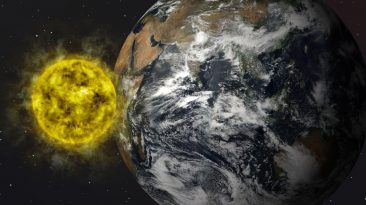If the Universe is full of stars, why doesn’t it appear white? And if it did, what would that look like?
Would all the black holes suddenly become visible? And if our sky was all white, would we still be able to see the stars?
Let me break something to you. Black is not a color… as far as physics is concerned.
By definition, color is the visible spectrum of light waves. A black object absorbs all the colors of the spectrum, making “black” an absence of any color. On the other hand, “white” is a mixture of all colors and it contains all wavelengths of visible light.
Color is about our sensory perception of the world. But going back to the background of the Universe, you could say it was white once.
When the Universe was born from the Big Bang, it didn’t have any stars to emit light. It was opaque with a hot soup of protons, electrons and neutrons.
After about 300,000 years, space cooled down and those particles began pairing up into atoms and molecules. The Universe became transparent. But to you, it would appear absolutely dark. Because not a single light source had formed yet. This was the era of cosmic dark ages. It ended when the first stars started fusing hydrogen into helium.
[dx_custom_adunit desktop_id=”RTK_CDE4″ mobile_id=”RTK_SUFd”]Those stars were up to 300 times more massive than our Sun, and millions of times brighter. They shined for a few million years before they exploded as supernovas.
The growing radiation from the those first stars ionized hydrogen atoms – split them back into protons and electrons. That’s when the dark Universe lit up. So, why didn’t it stay that way? Why with all the new stars and new galaxies, is our night sky no longer bright?
That is Olbers’ paradox. You see, if the Universe appeared to be white instead of black, it would mean that it’s infinitely old, infinitely big and static at the same time. That would make it a different Universe altogether.
We know that our Universe is just under 14 billion years old. That might seem like a long time, but remember, even light has its speed limit. We can only see stars that are less than 14 billion light years away from us. The light from more distant stars hasn’t had the time to reach Earth yet.
As our Universe keeps expanding, the distance between stars is increasing, too. As distant stars move further away from us, the wavelength of their light increases and shifts towards red. Until it becomes so long that the human eye can’t see it anymore. That’s another reason for the black background of the Universe. Space is filled with all kinds of radiation, you just can’t see it.
And what about the black holes? Well, even if a very powerful source of light illuminated our Universe, you still wouldn’t see any black holes. Those things have such a strong gravity, that they don’t emit any light and therefore can never be visible. Black is, after all, an absence of color.
It would be cool to catch a black hole one day and turn it into an infinite energy source.
Subscribe to What-If on Youtube or follow the show on Facebook Watch.
Sources
- “Reionization | Kavli Institute For Particle Astrophysics And Cosmology (KIPAC)”. 2019. kipac.stanford.edu. Accessed March 7 2019.
- ” First Light & Reionization – Webb/NASA”. 2019. jwst.nasa.gov. Accessed March 7 2019.
- “Are Black And White Colors?”. 2019. Encyclopedia Britannica. Accessed March 7 2019.
- “Why Isn’t The Sky Bright At Night If The Universe Has So Many Stars? (Intermediate) – Curious About Astronomy? Ask An Astronomer”. Rothstein, Dave. 2019. curious.astro.cornell.edu. Accessed March 7 2019.




























What if humans had not been on earth? Would it survive oly wit animals?